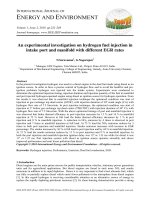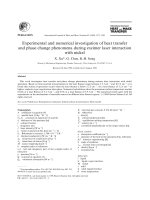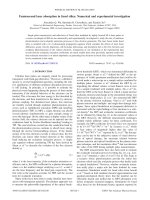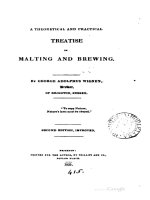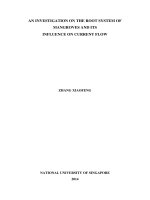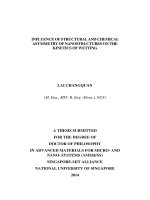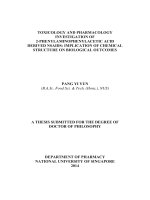Theoretical and experimental investigation on nanostructures
Bạn đang xem bản rút gọn của tài liệu. Xem và tải ngay bản đầy đủ của tài liệu tại đây (3.81 MB, 219 trang )
Theoretical and Experimental
Investigation on Nanostructures
PAN HUI
(B. Sc. Xidian University)
A THESIS SUBMITTED
FOR THE DEGREE OF DOCTOR OF PHILOSOPHY
DEPARTMENT OF PHYSICS
NATIONAL UNIVERSITY OF SINGAPORE
2006
Acknowledgements
I
ACKNOWLEDGEMENTS
First and foremost, I would like to express my sincerest gratitude to my supervisors,
Assoc. Prof. Feng Yuan Ping and principal scientist Lin Jianyi, for their invaluable
inspiration, guidance and encouragement throughout the course of my work.
I also would like to express my sincerest gratitude to Assoc. Prof. Ji Wei (Physics), Asst.
Prof. Sow Chorng Haur (Physics), Asst. Prof. Wang Xue Sen (Physics), Assoc. Prof.
Ding Jun (Material Science, especially for magnetic measurements and studies in Chapter
6), Prof. Huan Cheng Hon (NTU), Assoc. Prof. Shen Zexiang (NTU) and Prof You
Jinkua (Xiamen University), for their constant support, guidance and cooperation.
I also thank all my friends and group members, Chen Weizhe, Dong Yufeng, Gao Han
(IMRE), Gao Xinyu, Huang Min, Wang Yihua (Charter Semiconductor), Lim Sanhua,
Liu Binghai, Luo Jizhong (ICES), Ni Zhenghua, Peng Guowen, Poh Cheekok, Sun Han,
Sun Yiyang, Wang Yanhua, Wu Rongqing, Wu Xiaobing, Zhang Jie, Zhang Xinhuai
(computer center), Zhu Yanwu, Zheng Yuebing (IMRE), and Yi Jiabao (Material Science,
specially for magnetic measurement), for their cooperation, valuable discussion and help.
Particularly, I should thank my wife, Huang Jiayi, for her everlasting support and love.
Last but not least, I thank my parents and grandparents for their support, tolerance, and
love.
Table of contents
II
Table of Contents
Acknowledgments I
Table of Contents II
Summary VIII
List of Publications X
List of Tables XIII
List of Figures XIV
1. Introduction 1
1.1 Background 1
1.2 Motivation 9
1.3 Objectives 10
1.4 Organization of the Thesis 11
References 13
2. First-Principles Theory 15
2.1 Introduction 15
2.2 The Schrödinger Equation 16
2.3 The Hartree-Fock Approximation 18
2.4 Density Functional Theory 20
2.4.1 The Hohenberg-Kohn Theorems 21
2.4.2 The Kohn-Sham Equations 23
2.5 Local Density Approximation 25
2.6 Generalized-Gradient Approximation 27
2.7 Periodic Supercells 28
2.7.1 Bloch’s Theorem 28
Table of contents
III
2.7.2 k
G
-Point Sampling 29
2.7.3 Plane Wave Basis Sets 30
2.8 Nonperiodic Systems 31
2.9 Pseudopotential Method 32
2.10 Minimization of the Kohn-Sham Energy Functional 34
2.11 CASTEP Code 35
References 36
3. Carbon Nanoscrolls 38
3.1 Introduction 38
3.2 Calculation Details 39
3.3 Electronic Structures 40
3.3.1 Structural Properties 40
3.3.2 Electronic Properties 42
3.4 Optical Properties 46
3.5 Summary 50
References 51
4. Functionalization of Carbon Nanotubes 53
4.1 Introduction 53
4.2 OH-Functionalization of Single-Wall Carbon Nanotubes 54
4.2.1 Calculation Details 55
4.2.2 Binding Energy 56
4.2.3 Electronic Properties 56
4.2.4 Optical Properties 61
4.3 F- and Cl-Functionalization of Single-Wall Carbon Nanotubes 64
4.3.1 Calculation Details 64
Table of contents
IV
4.3.2 Binding Energy 65
4.3.3 Optimized Geometry 65
4.3.4 Electronic Properties 66
4.4 Summary 70
References 71
5. Boron Cabonitride Nanotubes 73
5.1 Introduction 73
5.2 Calculation Details 74
5.3 Geometrical Properties 74
5.4 Convergence of Total Energy 76
5.5 Electronic Properties 77
5.6 Optical Properties 81
5.6.1 Chirality and Size Dependence of Absorption Spectra 82
5.6.2 Chirality and Size Dependence of Loss Function 86
5.7 Summary 90
References 92
6. Carbon Doped ZnO 93
6.1 Introduction 93
6.2 Calculation Details 94
6.3 Calculation Results and Discussion 95
6.3.1 System Energy and Defect Stability 95
6.3.2 Magnetic Properties 95
6.4 Experimental Details 97
6.5 Experimental Results 98
6.5.1 Characterization of C-doped ZnO 98
Table of contents
V
6.5.2 Feromagnetism in C-doped ZnO 100
6.6 Summary 101
References 102
7. Porous Anodic Aluminum Oxide (AAO)-An Ideal Template For the Synthesis
of Nanostructures 103
7.1 Introduction 103
7.1.1 Solution-Based Approaches 103
7.1.2 Gas-Phase Growth Methods 104
7.1.3 Anodic Aluminum Oxide 105
7.2 Two-Step Process of AAO Growth 107
7.3 General Descriptions 107
7.4 Electrical Bridge Model for Self-Organization of AAO 110
7.4.1 Effect of Temperature 115
7.4.2 Effect of Applied Voltage 116
7.4.3 Effect of Acid Concentration 117
7.4.4 Effect of Annealing 117
7.5 Morphological Symmetry of AAO 118
7.6 Summary 120
References 121
8. Carbon Nanotubes Based on AAO Template 123
8.1 Introduction 123
8.2 Experimental Details 124
8.2.1 The Preparation of AAO Template 124
8.2.2 The Deposition of Co Catalysts on AAO Template 125
8.2.3 The Growth of CNTs 125
8.2.4 Characterization 126
Table of contents
VI
8.3 Results and Discussions 126
8.4 Summary 131
References 132
9. Metal Nanowires Based on AAO template 134
9.1 Introduction 134
9.2 Experimental Details 135
9.3 Single Crystal Growth of Metal Nanowires 136
9.3.1 Ni Nanowires 137
9.3.2 Co Nanowires 140
9.3.3 Ag Nanowires 140
9.3.4 Zn Nanowires 141
9.3.5 Growth Mechanism 141
9.4 Magnetic properties of Ni and Co naowires 146
9.5 Optical Limiting of Metal Nanowires 150
9.6 Summary 155
References 156
10. Semiconductor Nanostructures by Thermal Evaporation 158
10.1 Introduction: Thermal Evaporation Method 158
10.2 Si Nanowire Based on Theraml Evaporation 159
10.2.1 Silicon Nanowires 159
10.2.2 Experimental Details 160
10.2.3 Characterization of SiNWs 161
10.2.4 Effects of Growth Conditions 163
10.2.5 Growth Mechanism of SiNWs 164
10.2.6 Optical Properties of SiNws 166
Table of contents
VII
10.2.6.1 Photoluminescence 166
10.2.6.2 Optical Limiting 168
10.2.7 Summary 170
10.3 ZnO Nanostructures Based on Thermal Evaporation 171
10.3.1 ZnO Nanostructures 171
10.3.2 Experimental Details 172
10.3.3 Characterization of ZnO Nanostructures 173
10.3.4 Photoluminescence of ZnO Nanostructures 175
10.3.5 Field Emission of ZnO Nanostructures 176
10.3.6 Summary 178
10.4 Mg Doped ZnO Nanowires 178
10.4.1 Experimental Details 179
10.4.2 Characterization of Mg Doped ZnO Nanowires (Mg-
ZnONWs) 180
10.4.3 Optical Properties of Mg-ZnONWs 182
10.4.4 Electroluminescence of Mg-ZnONWs 185
10.4.5 Summary 185
10.5 Hydrogen Absorption of ZnO and Mg Doped ZnO Nanowires 186
10.5.1 Experimental Details 186
10.5.2 Hydrogen Storage 186
10.5.3 Summary 190
References 191
11. Conclusions and Recommendations 194
11.1 Contributions 194
11.2 Recommendations For Further Research 198
Summary
VIII
SUMMARY
Nanostructures have attracted increasing interests in theoretical physics, solid state
science and practical technological applications, such as nanodevices, optical devices, and
high-density storage. Among these nanostructures, carbon nanotubes, metal nanowires,
and semiconductor nanowires (Si and ZnO) are very important to future information
technology.
The overall objective of this thesis was to study the physical properties, i.e. structural,
electronic and optical properties, and to investigate the potential applications of these
nanostructures. In achieving this overall objective, both theoretical calculation and
experimental study had been successfully conducted.
Theoretically, first-principles
method was used to calculate the electronic and optical properties of these nanostructures.
Experimentally, template-based synthesis and thermal evaporation were employed to
fabricate the nanostructures to investigate their electronic and optical properties and to
identify their potential applications.
Calculations based on first-principles were carried out to study carbon and carbon-related
nanotubes. More specifically, the calculations have shown that carbon nanoscroll has
semi-metal property and shares the optical property of single-wall and multi-wall carbon
nanotubes. The calculations have also revealed that the functonalization of carbon
nanotubes can greatly change their electronic and optical properties, resulting in charge
transfer and reduction of band gap etc. The first-principles calculations have further been
extended to the study of boron carbonitride nanotubes and it has been found that their
Summary
IX
electronic and optical properties are dependent on the diameter and chirality. A combined
calculation and experiment method was used the study the magnetic property of C-doped
ZnO. Experimentally, anodic aluminum oxide (AAO) template was produced by a two-
step anodization process. A novel electrical bridge model has been proposed to
understand the self-assembly of the nanopores in the AAO. Then, AAO template was
used to produce highly-ordered carbon nanotubes and metallic nanowires. Template-
based synthesis illustrated that highly-ordered carbon nanotubes can be produced, which
were found useful in the interconnection of nanodevices after studying their electronic
properties. Single crystal metallic nanowires were obtained by template-synthesis. The
single-crystalline Ni and Co nanowires showed better magnetic properties than poly-
crystal nanowires. The nonlinear optical property of metallic nanowires was investigated.
Thermal evaporation of semiconductor nanowires, i.e. Si, ZnO and Mg doped ZnO
nanowires, demonstrated that catalyst-free growth is possible, which can be useful to
remove the metal impurity in semiconductors induced by catalyst in the process of
catalyst-assisted growth. Possible applications explored in the study, such as
electroluminescence and photoluminescence, showed that these nanostructures can be
used in nanodevices, optical devices and storage.
This study demonstrated that the research based on theoretical calculation and
experimental method is efficient and fruitful to study nanostructures. And it is possible to
extend the study to other systems.
List of publications
X
LIST OF PUBLICATIONS
1. Hui Pan, Weizhe Chen, Yuanping Feng, Wei Ji, Jianyi Lin, Optical limiting of
metal nanowires, Appl. Phy. Lett. 88, 223106 (2006). Also highlighted on
Virtual Journal of Nanoscale science & Technology 13 (23) (Jun 12, 2006)
and Photonics Spectra (Aug. 1, 2006).
2. Hui Pan, Yuanping Feng, Jianyi Lin, Ab initio study of single-wall BC
2
N
nanotubes, Phys. Rev. B 74, 045409 (2006). Also highlighted on Virtual
Journal of Nanoscale science & Technology 14 (4) (Jul. 24, 2006).
3. Hui Pan, Yuanping Feng, Jianyi Lin, First-principles study of optical spectra
of single-wall BC
2
N nanotubes, Phys. Rev. B 73, 0345420 (2006). Also
highlighted on Virtual Journal of Nanoscale science & Technology 13 (3)
(Jan. 23, 2006).
4. Hui Pan, Zhenhua Ni, Han Sun, Yuanping Feng, Zexiang Shen, Jianyi Lin,
Strong green emission of Mg doped ZnO nanowires, J. Nanoscience and
Nanotechnology 6, 2529–2532 (2006).
5. Hui Pan, Yanwu Zhu, Han Sun, Yuanping Feng, Chow Haur Sow, Jianyi Lin,
Electroluminescence and Field emission properties of Mg doped ZnO
tetrapods, Nanotechnology17, 5096-5100(2006).
6. Hui Pan, Yuanping Feng, Jianyi Lin, Magnetic properties of carbon doped
ZnO, to be submitted.
7. Hui Pan,
Han Sun, Yuanping Feng, Jianyi Lin, Hydrogen storage of ZnO and
Mg doped ZnO nanowires, Nanotechnology 17, 2963(2006).
8. Yuanping Feng, Hui Pan, Rongqing Wu, Guowen Peng, Jianyi Lin, Ab initio
study of functionalized nanotubes, Hard Nanomaterials, edited by H. S.
Nalwa, in press. (invited review)
9. Hui Pan,
Cheekok Poh, Yuanping Feng, Jianyi Lin, Supercapacitor electrodes
from carbon nanostructures, submitted.
10. Hui Pan, Yuanping Feng, Jianyi Lin, Ab initio study of F, Cl-functionalized
single wall carbon nanotubes, J. Phys: Conden. Mater. 18, 5175-5184(2006).
11. Hui Pan, Liying Tong, Yuan Ping Feng, Jianyi Lin, Enhancement of minority-
carrier lifetime by an advanced high temperature annealing method, Thin
Solid Films 504, 129-131 (2006).
List of publications
XI
12. Hui Pan, Yuanping Feng, Jianyi Lin, Ab initio study of electronic and optical
properties of multiwall carbon nanotube structures made up of a single rolled-
up graphite sheet, Phys. Rev. B 72, 085415 (2005). Also highlighted on
Virtual Journal of Nanoscale science & Technology 12 (7) (Aug. 15, 2005).
13. Hui Pan, Binghai Liu, Jiabao Yi, Cheekoh Poh, Sanhua Lim, Jun Ding,
Yuanping Feng and Jianyi Lin, Growth of single-crystalline Ni and Co
nanowires via electrochemical deposition and their magnetic properties, J.
Phys. Chem. B 109, 3094-3098 (2005).
14. Hui Pan, Yanwu Zhu, Zhenhua Ni, Han Sun, Cheekok Poh, Sanhua Lim,
Chornghaur Sow, Zexiang Shen, Yuanping Feng, Jianyi Lin, Optical and field
emission properties of ZnO nanostructures, J. Nanoscience and
Nanotechnology 5, 1683–1687 (2005).
15. Hui Pan, Han Sun, Cheekoh Poh, Yuanping Feng, Jianyi Lin, Single crystal
growth of metal nanowires with preferred orientation, Nanotechnology 16,
1559-1564 (2005).
16. Hui Pan, Jianyi Lin, Weizhe Chen, Han Sun, Yuanping Feng, and Wei Ji,
Optical limiting and hydrogen storage characterization of Cu, Cu
2
O and CuO
nanostructures, ICNT 2005 Proceeding.
17. Hui Pan, Zhenhua Ni, Han Sun, Cheekoh Poh, Zhexiang Shen, Yuanping
Feng, Jianyi Lin, Optical and Raman characterization of ZnO nanowires,
poster presented in the 3
rd
ICMAT (2005).
18. Hui Pan, Weizhe Chen, Sanhua Lim, Cheekoh Poh, Xiaobing Wu, Yuanping
Feng, Wei Ji, Jianyi Lin, Photoluminescence and optical limiting of Si
nanowires, J. Nanoscience and Nanotechnology 5, 733-737 (2005).
19. Hui Pan
, J.B. Yi, B.H. Liu, S. Thongmee, J. Ding, Yuan Ping Feng, Jian Yi
Lin, Magnetic properties of highly-ordered Ni, Co and their alloy nanowires in
AAO templates, Solid state Phenomena, 111, p123 (2006).
20. Hui Pan
, Sanhua Lim, Cheekoh Poh, Xiaobing Wu, Yuanping Feng, Jianyi
Lin, Growth of Si nanowires by thermal evaporation, Nanotechnology 16,
417-421 (2005).
21. Hui Pan, Yuanping Feng, Jianyi Lin, Ab initio study of OH-functionalized
single wall carbon nanotubes, Phys. Rev. B 70, 245425 (2004). Also
highlighted on Virtual Journal of Nanoscale science & Technology 11 (1)
(Jan. 10, 2005).
22. Hui Pan, Jianyi Lin, Yuanping Feng, Han Gao, Electrical bridge model on the
self-organized growth of nanopores in anodized Aluminum oxide, IEEE
Trans. On Nanotechnology 3(4), 462-467 (2004).
List of publications
XII
23. Hui Pan, Han Gao, Sanhua Lim, Yuanping Feng and Jianyi Lin, Highly
ordered carbon nanotubes based on porous aluminum oxide: fabrication and
mechanism, J. Nanoscience and Nanotechnology 4 (8), 1014-1018 (2004).
24. Han Gao, Jianyi Lin, Hui Pan, Guotao Wu, Yuanping Feng, The growth of
carbon nanotubes at predefined locations using nickel nanowires as templates,
Chem. Phys. Lett. 393, 511 (2004).
LIST OF PATENTS
1. Hui Pan, Jianyi Lin, Jun Ding, Yuanping Feng, “Single Crystal Growth of
Magnetic Nanowires", US Provisional Patent Application No. 60/607,111.
2. Hui Pan, Jianyi Lin, Yuanping Feng, “Synthesis of Mg doped ZnO nanowires and
their applications to optical devices and hydrogen storage", US Provisional Patent
Application No. 60/698,476
.
3. Hui Pan, Jianyi Lin, Yuanping Feng, “Supercapacitor from carbon tube-in-tube
nanostructures", US Provisional Patent Application No. 60/777,547.
4. Jin Chua Soo, Hailong Zhou, Jianyi Lin, Hui Pan, “Method of ZnO film grown on
the epitaxial lateral overgrowth GaN template”, submitted.
List of tables
XIII
LIST OF TABLES
Table 4.1, The calculated binding energy of halogen atom, equilibrium distance between
the halogen atom and the tube, and the amount of charge transfer from the
CNT to the halogen atom.
Table 5.1, Calculated band gap energies of various BC
2
N nanotubes.
Table 8.1, Conditions for the growth of CNTs based on AAO template and the results of
SEM.
Table 9.1, Coercviity H
c
and squarness of Ni and Co nanowires.
Table 9.2, The limiting threshold of metal nanowires at 532 nm and 1064 nm. The
limiting threshold of multi-wall carbon nanotubes (MWNTs) is also listed for
comparison.
List of figures
XIV
LIST OF FIGURES
Fig. 2.1, Schematic illustration of a supercell geometry for an array of carbon nanotubes.
Fig. 3.1, Initial structures of the two carbon nanoscrolls. Black and white balls indicate
carbon and hydrogen atoms, respectively.
Fig. 3.2 Optimized structures of the two carbon nanoscrolls in Fig. 3.1. Black and white
balls indicate carbon and hydrogen atoms, respectively.
Fig. 3.3 Calculated band structures of the two carbon nanoscrolls. The inserts are the fine
structures of the valence band top and conduction band bottom near the Fermi
level which is indicated by the dashed line.
Fig. 3.4 Calculated total density of states for (a) Model 1 and (b) Model 2, respectively.
The Fermi level is indicated by the dashed line.
Fig. 3.5 The electron density of (a) the valence band edge state of Model 1; (b) the
conduction band edge state of Model 1; (c) the valence band edge state of Model
2; (d) the conduction band edge state of Model 2.
Fig. 3.6 Reflection spectra of the two models, (a) for the polarization perpendicular to the
nanoscroll’s axis; (b) for the polarization parallel to the nanoscroll’s axis. The
dashed line (solid line) is for Model 1 (Model 2).
Fig. 3.7 Loss functions of the two models, (a) for the polarization perpendicular to the
nanoscroll’s axis; (b) for the polarization parallel to the nanoscroll’s axis. The
dashed line (solid line) is for Model 1 (Model 2).
Fig. 4.1, Top (a) and side (b) views of the SWCNT-OH supercell used in our calculation.
One OH group is attached on the wall of the SWCNT with the Oxygen atom
connected to the carbon atom.
Fig. 4.2, Band structure of the zigzag (10, 0) SWCNT, (b) shows its details near the Fermi
level (E
F
=0eV).
Fig. 4.3, Band structure of the SWCNT-OH system, (b) shows its details near the Fermi
level (E
F
=0eV).
Fig. 4.4, Electron density corresponding to (a) the E
0
level in the pure tube; (b) the E′
level crossing the Fermi level; (c) the E
01
level and (d) the E
02
level in the
tube−OH system, respectively.
Fig. 4.5, Calculated (a) total DOS of the pure SWCNT, (b) total DOS of SWCNT-OH.
The Fermi level is at 0 eV.
List of figures
XV
Fig 4.6, Loss functions of zigzag (10, 0) SWCNT. The dot line (solid line) corresponds to
the case when the polarization direction is perpendicular (parallel) to the axis of
the tube.
Fig. 4.7, Loss functions of the SWCNT−OH. The dotted line (solid line) corresponds to
the case when the polarization direction is perpendicular (parallel) to the axis of
the tube.
Fig. 4.8, The models of the SWCNT-Cl (a) and SWCNT–F (b) used in our calculation.
One F or Cl is attached on the wall of the SWCNT.
Fig. 4.9 (a) Band structure of the zigzag (10, 0) SWCNT near the Fermi level (E
F
=0 eV);
(b) band structure of the SWCNT-Cl system; (c) Band structure of the SWCNT-
F system.
Fig. 4.10, Density of State of (a) the N
1
level cross the Fermi level; (b) the N
2
level and
(c) the N
3
level in the tube−Cl system, respectively.
Fig. 4.11, Density of State of (a) the N
1
level cross the Fermi level; (b) the N
2
level and
(c) the N
3
level in the tube−F system, respectively.
Fig. 4.12, Calculated (a) total DOS of the pure SWCNT; (b) total DOS of SWCNT-Cl and
(c) total DOS of SWCNT-F. The Fermi level (dashed line) is at 0 eV.
Fig. 5.1. Atomic configuration of a BC
2
N sheet. Primitive and translational vectors are
indicated.
Fig. 5.2, The total energies of BC
2
N nanotubes and a BC
2
N sheet.
Fig. 5.3, The calculated band structures of (a) ZZ-1 (6, 0), (b) ZZ-1 (9, 0), (c) ZZ-1 (10,
0), (d) ZZ-2 (0, 3), (e) AC-1 (5, 5) and (f) AC-2 (5, 5).
Fig. 5.4, The change of band gap with increase of the diameter.
Fig. 5.5, Electron densities of (a) the top valence band and (b) the bottom conduction
band of ZZ-1 (6, 0); (c) the top valence band and (d) the bottom conduction
band of ZZ-1 (9, 0); (e) the top valence band and (f) the bottom conduction band
of ZZ-1 (12, 0).
Fig. 5.6, Absorption spectra of AC-1 (n, n): (a) for parallel light polarization and (b) for
perpendicular light polarization. The curves are displaced vertically for clarity
(also applies to other figures).
Fig. 5.7, Absorption spectra of AC-2 (m, m): (a) for parallel light polarization and (b) for
perpendicular light polarization.
Fig. 5.8, Absorption spectra of ZZ-1 (n, 0): (a) for parallel light polarization and (b) for
perpendicular light polarization.
List of figures
XVI
Fig. 5.9, Absorption spectra of ZZ-2 (0, m): (a) for parallel light polarization and (b) for
perpendicular light polarization.
Fig. 5.10, Loss functions of AC-1 (n, n): (a) for parallel light polarization and (b) for
perpendicular light polarization.
Fig. 5.11, Loss functions of AC-2 (m, m): (a) for parallel light polarization and (b) for
perpendicular light polarization.
Fig. 5.12, Loss functions of ZZ-1 (n, 0): (a) for parallel light polarization and (b) for
perpendicular light polarization.
Fig. 5.13, Loss functions of ZZ-2 (0, n): (a) for parallel light polarization and (b) for
perpendicular light polarization.
Fig. 6.1, Local structures for carbon substitution at O site.
Fig. 6.2, Calculated band structure of ZnO-C
o
. The dotted line is the Fermi level.
Fig. 6.3, Majority and minority spin DOS of ZnO-C
O
. The dotted line is the Fermi level.
Fig. 6.4, Electron densities of orbitals for ZnO-C
O
: (a)-(c) corresponding to energy levels
E1-E3 for spin up, respectively; (e)-(f) corresponding to energy levels E1-E3 for
spin down, respectively.
Fig. 6.5, SIMS result of ZnO doped with 1 at% carbon.
Fig. 6.6, XPS spectra of (a) carbon in ZnO without doping, (b) carbon in ZnO doped with
1% carbon, and (c) oxygen in ZnO doped with 1% carbon.
Fig. 6.7, Hall effect at different temperature of 1% C doped ZnO, a) 300 K; b) 80 K; c) 40
K; d) Hall effect of c) after deduction of abnormal part.
Fig. 6.8, Hysteresis loop of ZnO+1%C at 5 K and 300 K. The inset is the magnetization
dependence on temperature, which can be fitted with Block law (1-
M/M
a
)=BT
3/2
.
Fig. 7.1, Schematic drawing of the idealized hexagonal structure of anodic porous
alumina. (a) The columnar cell is perpendicular to the nanopore axis; (b) is
parallel to the nanopore axis.
Fig. 7.2, The SEM image shows the morphology of the AAO template. The diameter of
nanopore is about 30 nm, and the interpore distance is about 100 nm. The
anodization was carried out in 3%w oxalic acid, at 40 V and room temperature.
Fig. 7.3, Schematic drawing of the cross section of the nanopores with different sizes and
the metal edge are illustrated for discussion.
List of figures
XVII
Fig. 7.4, (a) an electrical bridge model, where R
1
and R
2
are constant resistors and equal,
corresponding to the resistances of electrolytes in different nanopores. U
i
(i=1,2)
is the potential at the end of bridge. R
x
and R
v
are the unknown resistor and
variant resistor, respectively, corresponding to R
xi
(i=1,2) the resistance of
oxide layer. (b) schematic representation of corresponding electrical bridge
model for two nearest nanopores compared to (a). U
i
(x=1,2) is the potential at
the e/o interface.
Fig. 7.5, Schematic representation of the cross section of the barrier layer where the oxide
formation zone and the oxide dissolution zone adjacent to the m/o interface and
the e/o interface, respectively, and the ionic movement and the electric field are
shown (a). The current model corresponding to the ionic drift is illustrated in
(b).
Fig. 8.1, (a) The SEM image of a typical AAO template prepared by the two-step
anodization at 23
o
C using 3%w oxalic acid and 40 V voltage and (b) the SEM
image of Co particles with the diameter around 40 nm. The AAO template has
been removed by phosphoric and chromic acids.
Fig. 8.2, SEM images of CNTs based on AAO template: (a) CNTs formed within
nanopores of a thick AAO template without the presence of Co (Sample 3). (b)
CNTs formed within nanopores of a thick AAO template (Sample 2). (c) CNTs
growing out of nanopores on an AAO template with short pore length (Sample
1); (d) A CNT with a diameter of 28nm growing out of the nanopore on an AAO
template with large diameter (around 50nm) (Sample 1).
Fig. 8.3, Raman spectra of the AAO-template-grown CNTs samples: (a) from Sample 5
and 6 by using ethylene as the hydrocarbon source with the presence of
electrodeposited Co catalysts; (b) from Samples 1, 2, and 4 by using acetylene
and electrodeposited Co catalysts; (c) From Sample 3, 7 and 9 without Co
catalysts.
Fig. 9.1, SEM images of Ni nanowires (a) with the alumina is partially, (b) with the
alumina is completely removed and (c) dispersed on Si substrate.
Fig. 9.2, XRD patterns for (a) Ni-1, (b) Ni-2, (c) Ni-3, (d) Ni-4, (e) Ni-5, (f) Ni-6 and (g)
Ni-7.
Fig. 9.3, TEM images and selective area electron diffraction patterns of Ni nanowires: (a)
a Ni nanowire in Ni-3: the inset is the corresponding selective area ED, and the
circle indicates that the size of selected area is as large as ~2.0 µ.; (b) HRTEM
of Ni-3: the 0.203 nm interlayer spacing is characteristic of Ni (111) planes, and
[220] is along the nanowire long axis; (c) Ni nanowires in Ni-4, and (d)
HRTEM images of Ni-4.
Fig. 9.4, XRD patterns for Co samples (a) Co-1 and (b) Co-2.
Fig. 9.5, XRD pattern for Ag-1 (a) and TEM image (b) with the SAED inserted.
List of figures
XVIII
Fig. 9.6, XRD pattern for Zn-1.
Fig. 9.7, schematic representation of different growth modes in metal deposition on
foreign substrate depending on the binding energy of metal atom on substrate
(γ
ms
), compared to that of metal atoms on native substrate (γ
mm
), and on the
crystallographic misfit characterized by interatomic distances d
m
and d
s
of 3D
metal and substrate bulk phases, respectively. (a) “Volmer-Weber” growth mode
(3D metal island formation) for γ
ms
<<γ
mm
independent of the ratio (d
m
-d
s
)/d
s
. (b)
“Stranski-Krastanov” growth mode (metal layer-by-layer formation) for
γ
ms
>>γ
mm
and the ratio (d
m-
d
s
)/d
s
<0 (negative misfit) or (d
m
-d
s
)/d
s
>0 (positive
misfit). (c) “Frank-van der Merwe” growth mode (metal layer-by-layer
formation) for γ
ms
>>γ
mm
and the ratio (d
m
-d
s
)/d
s
≈0.
Fig. 9.8, Schematic cross section (perpendicular to the substrate) of the columnar
deposition.
Fig. 9.9, Magnetization curves of the Ni nanowires embedded in the AAO template: (a)
Ni-1, b) Ni-2, c) Ni-3. Solid line is for the applied magnetic field parallel to the
long axe while dashed line for the perpendicular field.
Fig. 9.10, Magnetization curves of the Co nanowires embedded in the AAO template: (a)
Co-1 and (b) Co-2. Solid line is for the applied magnetic field parallel to the
long axe while dashed line for the perpendicular field.
Fig. 9.11, (a) The XRD patterns of the MNWs and (b) The optical absorption spectra of the
MNWs.
Fig. 9.12, The optical limiting response of the MNWs measured with 7-ns laser pulses at
(a) 532-nm; and (b) 1064-nm wavelength.
Fig. 9.13, Nonlinear scattering measured with 532-nm, 7-ns laser pulses at a forward
angle of 10º with a solid angle of 0.015 rad. The inset shows the scattered
energy of the NiNW and the MWNT as a function of the input fluence at various
forward angles.
Fig. 10.1, The schematic diagram of the thermal-evaporation growth apparatus.
Fig. 10.2, The SEM images of SiNWs produced by thermal-evaporation based on Si
substrate. (a) A typical SEM image of SiNWs at the center of the Si substrate;
(b) A local view of the SiNWs.
Fig. 10.3, The Raman shift of SiNWs measured at room temperature.
Fig. 10.4, The XRD spectrum of SiNWs measured at room temperature.
Fig. 10.5, (a) TEM micrograph showing the morphology of Si nanowires grown on Si
substrate; (b) the SEAD pattern taken from the nanowires located at the center
List of figures
XIX
of the substrate; (c) the SEAD pattern taken from the nanowires located at the
edge of the substrate.
Fig, 10.6, SEM image of SiNWs produced at a pressure of (a) 50 Pa, (b) 8000 Pa and (c)
atmosphere pressure.
Fig. 10.7, (a) The “Octopus” structure of SiNWs at the center of the Si substrate and (b)
SiNWs at the edge of the Si substrate.
Fig. 10.8, The photoluminescence (PL) spectrum of the SiNWs recorded at room
temperature with using a high intensity Xenon lamp as excitation source.
Fig. 10.9, The optical limiting measurements of the SiNWs and SiPW measured with 7-ns
laser pulses at (a) 532-nm; and (b) 1064-nm wavelength. Both multiwalled
carbon nanotubes (MWNTs) and C
60
samples are used as the reference samples.
The inset shows the optical transmission spectra for the SiNWs and SiPW.
Fig. 10.10, SEM images of ZnON: (a) ZnON-A and (b) ZnON-B. The insets in the figures
show close-up view of the pike tip at higher magnifications.
Fig. 10.11, XRD patterns for: (a) ZnON-A and (b) ZnON-B.
Fig. 10.12, Selective area electron diffraction pattern of ZnON-A.
Fig. 10.13, Raman spectra with the excitation of 514.5 nm laser light for: (a) ZnON-A and
(b) ZnON-B.
Fig. 10.14, Photoluminescence spectra obtained using Xenon lamp at 160 W as excitation
source for: (a) ZnON-A and (b) ZnON-B;
Fig. 10.15, Field emission measurement for ZnON-A (open symbols) and ZnON-B (solid
symbols).
Fig. 10.16, Setup of the EL measurement.
Fig. 10.17, SEM images of Mg-ZnONWs in (a) large scale and (b) local scale.
Fig. 10.18, XRD pattern of Mg-ZnONWs.
Fig. 10.19, XPS spectrum of Mg-ZnONWs.
Fig. 10.20, Raman spectra of Mg-ZnONWs.
Fig. 10.21, Optical spectra of Mg-ZnONWs (a) transmittance and (b) photoluminescence.
Fig. 10.22, Direct view of green light emission from Mg-ZnONWs.
List of figures
XX
Fig. 10.23, Electroluminescence spectrum of Mg-ZnONWs with an applied field of 1.6
V/µm.
Fig. 10.24, The pressure-composition isotherms of the three samples, i.e. commercial
ZnO, ZnON and Mg-ZnON, taken at room temperature.
Fig. 10.25, TPD profiles of hydrogen-saturated Mg-ZnON and ZnON from room
temperature to 350
o
C, ramp rate = 10
o
C/min, using argon as carrier.
Fig. 10.26, Raman scattering for (a) com-ZnO, (b) ZnON.
Fig. 10.27, Schematic diagram of wurtzite structured ZnO: 1-5 are possible sites of
hydrogen absorption.
Chapter 1 Introduction
1
CHAPTER 1
INTRODUCTION
1.1 Background
Nanotechnology arises from the exploitation of physical, chemical, and biological
properties of systems that are intermediate in size between isolated atoms/molecules and
bulk materials, where phenomena length scales become comparable to the size of the
structure. It is recognized as an emerging technology of the 21
st
century, along with the
already established areas of computer/information technology and biotechnology. New
experimental and simulation tools emerging in the last few years and the discovery of
novel phenomena and processes at the “nano” scale have opened revolutionary
opportunities for developments in nanoparticles, nanostructured materials, and
nanodevices. Nanostructures, including nano-clusters, nano-layers, nano-tubes, nano-
wires and two and three-dimensional structures in the size range between the dimensions
of molecules and 50 nm (or in a broader sense, submicron sizes as a function of materials
and targeted phenomena), are seen as tailored precursors for building up functional
structures. The physical, chemical, and biological properties of these nanostructures may
be significantly different from those of corresponding bulk materials, and desirable novel
or enhanced properties may be obtained at this nanoscale. The two main reasons for this
change in behaviour are an increased relative surface area, and the dominance of quantum
effects. An increase in surface area (per unit mass) will result in a corresponding
enhancement of chemical reactivity, making nanomaterials useful with higher efficiency.
As the size of matter is reduced to nanometer scale, quantum effects can begin to play a
role, and these can significantly change a material’s electronic, optical, magnetic
Chapter 1 Introduction
2
properties. For example, the band gap of nanometer-scale semiconductor structures
increases as the size of the microstructure decreases, raising expectations for many
possible optical and photonic applications
1
. The emerging science of nanotechnology will
affect not only the fundamental theories, but also the competitive global positions of
companies. The potential impact is considerable nanostructured materials or nano-
processed devices have broad applications from pharmaceuticals, bioengineering,
pigments, and electronics to optical and magnetic devices and structures and coatings
with special properties.
Research and development (R&D) in this field emphasize scientific discoveries in the
generation of nanostructures with controlled characteristics; understanding of the physics
of new phenomena and processes at nanoscales (1-100 nm); research on their processing
into microstructured bulk materials with engineered properties and technological
functions; and introduction of new device concepts and manufacturing methods. R&D in
this field is stimulating the development of new modeling and experimental tools for the
mentioned purposes. This thesis will focus on the theoretical and experimental study of
one-dimension nanostructures to control their physical properties and investigate their
possible applications.
One-dimensional nanostructures, nanotubes and nanowires, are of great interest in
theoretical physics, solid state science and practical technological applications due to their
periodic structure in one-direction, which can induce new physical phenomena
2,3,4
. These
nanostructures are seen as precursors of devices with tailored properties. Among these
one-dimension nanostructures, carbon nanotubes, metal nanowires and semiconductor
Chapter 1 Introduction
3
nanowires are very important to information technology in the future, for their
applications in high-density storage devices, nanolaser, and spintronics
5,6,7
. Theoretical
calculation and experimental study on these 1-D nanostuctures can reveal their physical
properties, predict new materials and develop their applications.
Carbon nanotubes (CNTs)
8
are formed when a graphite sheet is curled up into cylinders.
Generally, there are two kinds of CNTs: single-wall CNT (SWCNT) and multi-wall CNT
(MWCNT). A SWCNT can be described as a single layer of a graphite crystal rolled up
into a seamless cylinder, one atom thick, usually with a small number of carbon atoms
along the circumference and a long length (microns) along the cylinder axis
9,10,11
. A
carbon nanotube is specified by the chiral vector
h
C
G
,
),(
21
mnamanC
h
≡+=
G
G
G
(1.1)
which is often described by the pair of indices (n, m) that denote the numbers of unit
vectors
1
a
G
and
2
a
G
in the
h
C
G
vector of the hexagonal honeycomb lattice. The so-called
zigzag nanotubes correspond to n=0 or m=0, whereas the so-called armchair nanotubes
correspond to n=m, and the nanotube axis for the so-called chiral nanotubes correspond to
n≠m≠0. The electronic properties of SWCNTs are correlated with their chirality and
diameter. Armchair carbon nanotubes with the chiral index (n, n) are metallic
12,13
, while
zigzag carbon nanotubes (n, 0) are semiconductors except for the case of n=3k (k is an
integer), which is narrow gap semiconductor due to the curvature if n is not large
enough
14,15,16
. Chiral carbon nanotubes are mostly semiconductors except for the case of
n-m=3k. The band gap of Chiral SWCNT is controlled by its diameter,
d
E
g
1
∝ , where d
is the diameter of the SWCNT
12,17
.
Chapter 1 Introduction
4
There are two kinds of MWCNT, i.e., Russian doll and Swiss scroll (carbon nanoscroll)
18
.
Russian doll structure refers to the nested carbon nanotubes, while Swiss scroll structure
represents the rolled-up graphene sheet
8,19
. Most studies of the MWCNT have focused on
the Russian doll and revealed that the intershell spacing d
002
ranges from 0.34 to 0.39 nm,
increasing with decreasing tube diameter
20,21
. MWCNTs are metallic, except for some
double- or trio-wall CNTs for which a gap or pseudo-gap can be induced due to the inter-
tube interaction or the lowering of symmetry
21
. Even though there have been many
studies on Russian doll structure, to date, there has not been any first-principles
calculation reported on carbon nanoscrolls. Hence, theoretical study of carbon nanoscrolls
becomes one of the objectives of the thesis.
The physical properties of CNT are greatly related to its size. Does metal nanowire have
the same relations? Metal nanowires are one of the most attractive materials because of
their unique properties that may lead to a variety of applications. Examples include
interconnects for nanoelectronics, magnetic devices, chemical and biological sensors, and
biological labels
22
. In terms of electron transport properties, metal nanowires can be
described as classical wires or quantum wires. The electron transport in a classical wire
obeys the classical relation:
L
A
G
σ
= (1.2)
where G is the conductance, and L and A are the length and the cross-sectional area of the
wire, respectively.
σ
in Eq. (1.2) is the conductivity, which depends on the material of the
wire. The classical behavior arises if the wires are much longer than the electron mean-
free path, and much thicker than the electron Fermi wavelength. The Fermi wavelength is
related to the size of the nanostructure (diameter and length). For example, The Fermi
